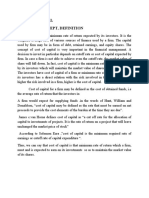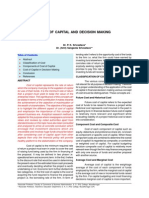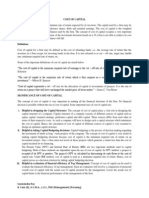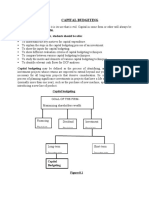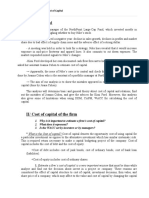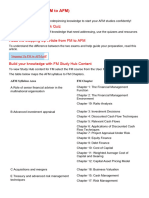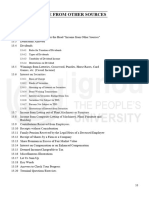Module in Financial Management - 08
Uploaded by
Karla Mae GammadModule in Financial Management - 08
Uploaded by
Karla Mae GammadUnit 5: Investing in Long-Term Assets: Capital
Budgeting
(6 hours)
Introduction
In the past modules, we explained how risk influences prices and required
rates of return on bonds and stocks. A firm’s primary objective is to maximize
its shareholders’ value. The principal way value is increased is by investing in
projects that earn more than their cost of capital. In the next two modules, we
will see that a project’s future cash flows can be forecasted and that those cash
flows can be discounted to find their present value. Then if the PV of the
future cash flows exceeds the project’s cost, the firm’s value will increase if
the project is accepted. However, we need a discount rate to find the PV of the
future cash flows, and that discount rate is the firm’s cost of capital. Finding
the cost of the capital required to take on new projects is the primary focus of
Module 8.
After learning cost of capital, Module 9 on the other hand will bring you to the
decisions that involved long-lived assets. These decisions involve both
investing and financing choices. When a business makes a capital investment,
it incurs a current cash outlay in the expectation of future benefits. Usually,
these benefits extend beyond one year in the future. Examples include
investment in assets, such as equipment, buildings, and land, as well as the
introduction of a new product, a new distribution system, or a new program
for research and development. In short, the firm’s future success and
profitability depend on long-term decisions currently made.
Learning Outcomes
At the end of this unit, students will be able to:
Define “capital budgeting” and identify the steps involved in the capital
budgeting process;
Justify why cash, not income, flows are the most relevant to capital
budgeting decisions.
Define the terms “sunk cost” and “opportunity cost” and explain why sunk
costs must be ignored, whereas opportunity costs must be included, in
capital budgeting analysis.
Financial Management Module 1
Topic 8: The Cost of Capital
Learning Objectives
At the end of this topic, students will be able to:
Explain how a firm creates value, and identify the key sources of value
creation.
Define the overall “cost of capital” of the firm.
Calculate the costs of the individual components of a firm’s overall
cost of capital: cost of debt, cost of preferred stock, and cost of equity.
Explain and use alternative models to determine the cost of equity,
including the dividend discount approach, the capital-asset pricing
model (CAPM) approach, and the before-tax cost of debt plus risk
premium approach.
Calculate the firm’s weighted average cost of capital (WACC) and
understand its rationale, use, and limitations.
Explain how the concept of Economic Value Added (EVA) is related
to value creation and a firm’s cost of capital.
Understand the capital-asset pricing model’s role in computing project-
specific and group specific required rates of return.
Activating Prior Learning
Situation:
Imagine that you are at lost in the wilderness and there is a substitution cypher
(a method of encrypting message in which the letters of the original text are
systematically replaced by different alphabet) that you need to answer to solve
your dilemma.
A B C D E F G H I J K L M N O P Q R S T U V W X Y Z
S T U V WX Y Z A B C D E F G H I J K L M N O P Q R
Hint: You have to capitalize on it to be successful in business.
Encrypted word: UGEHWLALANW SVNSFLSYW
Answer: __________________________________
Financial Management Module 2
Presentation of Contents
COST OF CAPITAL
- Cost of capital is an integral part of investment decision as it is used to
measure the worth of investment proposal provided by the business concern.
- It is used as a discount rate in determining the present value of future cash
flows associated with capital projects. Cost of capital is also called as cut-off
rate, target rate, hurdle rate and required rate of return.
When the firms are using different sources of finance, the finance manager
must take careful decision with regard to the cost of capital; because it is
closely associated with the value of the firm and the earning capacity of the
firm.
VALUE CREATION
- Ones that provide expected returns in excess of what the financial markets
require.
Industry Attractiveness
Growth Barriers to Other
phase of competitive protective
product devices –
entry
e.g. patents,
cycle
monopoly
Perceive Superior
Cost Marketing and Quality Organizational
Price Capability
Competitive Advantage
2 Major Sources
Industry Attractiveness
- Industry attractiveness has to do with the relative position of an industry
in the spectrum of value-creating investment opportunities. Favorable
industry characteristics include positioning in the growth phase of a
product cycle, barriers to competitive entry, and other protective
devices, such as patents, temporary monopoly power, and/or oligopoly
pricing where nearly all competitors are profitable.
Competitive Advantage
- The avenues to competitive advantage are several: cost advantage,
marketing and price advantage, perceived quality advantage, and
superior organizational capability (corporate culture).
Financial Management Module 3
MEANING OF COST OF CAPITAL
- Cost of capital is the rate of return that a firm must earn on its project
investments to maintain its market value and attract funds.
- If a firm fails to earn return at the expected rate, the market value of the
shares will fall and it will result in the reduction of overall wealth of the
shareholders.
- Rely on return (yield) calculations to determine cost figures because “cost”
and “return” are essentially two sides of the same coin.
Return
Cost
IMPORTANCE OF COST OF CAPITAL
Computation of cost of capital is a very important part of the financial
management to decide the capital structure of the business concern.
ASSUMPTION OF COST OF CAPITAL
Cost of capital is based on certain assumptions which are closely associated
while calculating and measuring the cost of capital.
It is to be considered that there are three basic concepts:
1. It is not a cost as such. It is merely a hurdle rate.
2. It is the minimum rate of return.
3. It consists of three important risks such as zero risk level, business risk
and financial risk.
Cost of capital can be measured with the help of the following equation.
K = rj + b + f.
Where,
K = cost of capital.
rj = the riskless cost of the particular type of finance.
b = the business risk premium.
f = the financial risk premium.
CLASSIFICATION OF COST OF CAPITAL
Cost of capital may be classified into the following types on the basis of nature
and usage:
Explicit and Implicit Cost.
Average and Marginal Cost.
Historical and Future Cost.
Specific and Combined Cost.
Financial Management Module 4
Explicit and Implicit Cost
- Explicit cost is the rate that the firm pays to procure financing.
- Implicit cost is the rate of return associated with the best investment
opportunity for the firm and its shareholders that will be forgone if the
projects presently under consideration by the firm were accepted.
Average and Marginal Cost
- Average cost of capital is the weighted average cost of each component
of capital employed by the company. It considers weighted average cost
of all kinds of financing such as equity, debt, retained earnings etc.
- Marginal cost is the weighted average cost of new finance raised by the
company. It is the additional cost of capital when the company goes for
further raising of finance.
Historical and Future Cost
- Historical cost is the cost which has already been incurred for financing
a particular project. It is based on the actual cost incurred in the previous
project.
- Future cost is the expected cost of financing in the proposed project.
Expected cost is calculated on the basis of previous experience.
Specific and Combine Cost
- The cost of each sources of capital such as equity, debt, retained
earnings and loans is called as specific cost of capital.
- The composite or combined cost of capital is the combination of all
sources of capital. It is also called as overall cost of capital. It is used to
understand the total cost associated with the total finance of the firm.
Cost of Capital
Cost of capital is the required rate of return on its investments which belongs
to equity, debt and retained earnings. If a firm fails to earn return at the
expected rate, the market value of the shares will fall and it will result in the
reduction of overall wealth of the shareholders.
The overall cost of capital is a weighted average of the individual required
rates of return (costs).
– It is the firm’s required rate of return that will just satisfy all capital
providers
The overall cost of capital of a firm is a proportionate average of the costs of
the various components of the firm’s financing.
1. Cost of equity capital – the required rate of return on investment of the
common shareholders of the company.
2. Cost of debt – The required rate of return on investment of the lenders of
the lenders of a company.
3. Cost of preferred stock – The required rate of return on investment of
the preferred shareholders of the company.
Financial Management Module 5
(a) (b) (a x b) (c) (b x c)
Capital Invested % Annual Peso Proportion Weighted
Providers Capital Cost Annual of Total Cost
(Investor Cost (Inv. Financing
Return) Return)
Debt P 2,000 5% P 100 20% 1.0%
P. Stock 3,000 10% 300 30% 3.0%
C. Stock 5,000 15% 750 50% 7.5%
P10,000 P 1,150 100% 11.5%
COST OF DEBT
- Cost of debt is the after tax cost of long-term funds through borrowing. Debt
may be issued at par, at premium or at discount and also it may be perpetual
or redeemable.
Debt Issued at Par
Debt issued at par means, debt is issued at the face value of the debt. It may be
calculated with the help of the following formula.
Kd = (1 – t) R
Where,
Kd = Cost of debt capital
t = Tax rate
R = Debenture interest rate
Debt Issued at Premium or Discount
If the debt is issued at premium or discount, the cost of debt is calculated with
the help of the following formula.
I
Kd = N (1 − 𝑡)
p
Where,
Kd = Cost of debt capital
I = Annual interest payable
Np = Net proceeds of debenture
t = Tax rate
Cost of Perpetual Debt and Redeemable Debt
It is the rate of return which the lenders expect. The debt carries a certain rate
of interest.
I+(𝑃−Np )n
Kdb = (𝑃+Np )/2
Where,
Kdb = Cost of debt before tax
I = Annual interest payable
P = Par value of debt
Np = Net proceeds of debenture
n = Number of years to maturity
Financial Management Module 6
Cost of debt after tax can be calculated with the help of the following formula:
Kda = Kdb × (1–t)
Where,
Kdb = Cost of debt before tax
Kda = Cost of debt after tax
t = Tax rate p
Hedging (Maturity Matching) Approach
- A method of financing where each asset would be offset with a financing
instrument of the same approximate maturity.
- the firm will finance a capital project, whose benefits extend over a number
of years, with financing that is generally long term in nature.
The explicit cost of debt can be derived by solving for the discount rate, kd,
that equates the market price of the debt issue with the present value of interest
plus principal payments and by then adjusting the explicit cost obtained for the
tax deductibility of interest payments. The discount rate, kd, known as the
yield to maturity, is solved for by making use of the formula
𝑛
It + Pt
𝑃0 = ∑
(1 + K d )t
𝑡=1
Where:
PO = current market price
∑ = summation for the periods 1 through n (final maturity)
It = Interest payment in period t
Pt = Payment of principal in period t
kd = discount rate
After tax cost of debt Ki
Ki = Kd (1- t)
You should note that the percent after-tax cost represents the marginal, or
incremental, cost of additional debt. It does not represent the cost of debt
funds already employed.
“Because predicting the effect of capital investment decisions on stock prices
is an inexact science (some would call it an art form), estimating the
appropriate required rate of return is inexact as well.”
COST OF PREFERRED STOCK
The cost of preferred stock is a function of its stated dividend.
Dividend is not a contractual obligation of the firm but, rather, is payable at
the discretion of the firm’s board of directors. Consequently, unlike debt, it
does not create a risk of legal bankruptcy. To the holders of common stock,
however, preferred stock is a security that takes priority over their securities
when it comes to the payment of dividends and to the distribution of assets if
the company is dissolved. Most corporations that issue preferred stock fully
intend to pay the stated dividend.
Financial Management Module 7
There are two types of preference shares irredeemable and redeemable.
Cost of redeemable preference share capital
- Because preferred stock has no maturity date, its cost, k p, may be
represented as:
kp = Dp /P0
Where: Dp = stated annual dividend
Po = current market price of the P-stock
Note that cost is not adjusted for taxes because the preferred stock dividend is
already an after-tax figure – preferred stock dividends being paid after taxes.
Thus the explicit cost of preferred stock is greater than that for debt.
Cost of irredeemable preference share capital
Dp + ( P − Np )/n
𝐾𝑝 =
(P + Np )/2
Where,
Kp = Cost of preference share
Dp = Fixed preference share
P = Par value
Np = Net proceeds of the preference share
n = Number of maturity period.
COST OF EQUITY CAPITAL
Cost of equity can be calculated from the following approach:
• Dividend price (D/P) approach
• Dividend price plus growth (D/P + g) approach
• Earning price (E/P) approach
• Realized yield approach.
Dividend Price Approach
The cost of equity capital will be that rate of expected dividend which will
maintain the present market price of equity shares.
Dividend price approach can be measured with the help of the following
formula:
𝐷
Ke = 𝑁
𝑝
Where,
Ke = Cost of equity capital
D = Dividend per equity share
Np = Net proceeds of an equity share
Dividend Price Plus Growth Approach
The cost of equity is calculated on the basis of the expected dividend rate
per share plus growth in dividend. It can be measured with the help of the
following formula:
𝐷
Ke = 𝑁 + 𝑔
𝑝
Financial Management Module 8
Where,
Ke = Cost of equity capital
D = Dividend per equity share
g = Growth in expected dividend
Np = Net proceeds of an equity share
Earning Price Approach
Cost of equity determines the market price of the shares. It is based on the
future earnings prospects of the equity. The formula for calculating the cost
of equity according to this approach is as follows.
𝐸
Ke = 𝑁
𝑝
Where,
Ke = Cost of equity capital
E = Earnings per share
Np = Net proceeds of an equity share
Realized Yield Approach
It is the easy method for calculating cost of equity capital. Under this
method, cost of equity is calculated on the basis of return actually realized
by the investor in a company on their equity capital.
Ke = PVf×D
Where,
Ke = Cost of equity capital.
PVƒ = Present value of discount factor.
D = Dividend per share.
The cost of equity capital, ke, can be thought of as the discount rate that
equates the present value of all expected future dividends per share, as
perceived by investors at the margin, with the current market price per share.
D1 D2 D∞
𝑃0 = + + ⋯ +
(1 + K e )1 (1 + K e )2 (1 + K e )∞
∞
Dt
𝑃0 = ∑
(1 + K e )t
𝑡=1
Where:
P0 is the market price of a share of stock at time 0
Dt is the dividend per share expected to be paid at the end of time period t
ke is the appropriate discount rate
Σ represents the sum of the discounted future dividends from period 1 through
infinity, depicted by the symbol ∞.
Capital-Asset Pricing Model Approach
Rj = Rf + (Rm − Rf)βj
Where,
Rj = Required Rate of Return
Rf = Risk-free rate,
Rm = Expected return for the market portfolio
βj = beta coefficient for stock j
Financial Management Module 9
…because of the market’s aversion to systematic risk, the greater the beta of a
stock, the greater its required return
Suppose that the beta for XYZ Company was found to be 1.20, based on
monthly excess return data over the last five years. Assume that a rate of
return of about 13 percent on stocks in general is expected to prevail and that a
risk-free rate of 8 percent is expected.
The cost of equity capital would be
Rj = 0.08 + (0.13 − 0.08)(1.20) = 14%
WEIGHTED AVERAGE COST OF CAPITAL (WACC)
Weighted average cost of capital is the expected average future cost of funds
over the long run found by weighting the cost of each specific type of capital
by its proportion in the firm’s capital structure.
The computation of the overall cost of capital (Ko) involves the following
steps.
(a) Assigning weights to specific costs.
(b) Multiplying the cost of each of the sources by the appropriate weights.
(c) Dividing the total weighted cost by the total weights.
Thus the firm’s overall cost of capital can be expressed as
Ko = Kd Wd + Kp Wp + Ke We
Where W means percentage of equity to total capital
Weighted average cost of capital is calculated in the following formula also:
∑ XW
Kw = ∑ W
Where;
Kw = Weighted average cost of capital
X = Cost of specific sources of finance
W = Weight, proportion of specific sources of finance.
Also;
𝑛
Cost of capital = ∑ kx (Wx )
𝑥=1
Where;
kx = after-tax cost of the xth method of financing
Wx = weight given to that method of financing as a percentage of the firm’s
total financing
Σ = denotes the summation for financing methods 1 through n.
Financial Management Module 10
To illustrate the calculations involved, suppose that a firm had the following
financing at the latest balance sheet statement date, where the amounts
shown in the table below represent market values.
Amt. of Proportion After-tax Weighted
Financing Cost Cost
Debt P 30M 30% 6.6% 1.98%
Preferred 10M 10% 10.2% 1.02%
Stock
Common 60M 60% 14.0% 8.40%
Stock
P 100M 100% 11.40%
Economic Value Added (EVA)
A measure of business performance. It is a type of economic profit, which is
equal to a company’s after-tax net operating profit minus a cost of capital
charge (and possibly including some adjustments).
EVA is the trademarked name for a specific approach to calculating economic
profit developed by the consulting firm of Stern Stewart & Co.
Net operating profit after tax (NOPAT)
A company’s potential after-tax net profit if it was all-equity-financed
or “unlevered.”
EVA is the economic profit a company earns after all capital costs are
deducted. More specifically, it is a firm’s net operating profit after tax
(NOPAT) minus a dollar-amount cost of capital charge for the capital
employed.
Illustration:
Net (adjusted) operating profit after taxes 34,910,000
Less: Average capital employed × Cost of capital
P94,170,000 × 14.97% 14,097,249
Economic value added 20,812,751
Financial Management Module 11
Application
Answer the following questions below (5 points each).
Essay
1. Assume that the risk-free rate increases. What impact would this have on
the cost of debt? What impact would it have on the cost of equity?
- If risk free rate increases, but market risk premium remains constant,
then the required return of stocks will increase that will lead to an
increase to the cost of equity. Since cost of equity can be solved by
adding risk free rate and market risk premium means as risk free rate
increases and the market risk premium is constant, cost of equity will
also increase. The cost of debt will also increase as risk-free rate
increases since risk free rate is one of the factors that determines
corporate bond rates. Wherein corporate bonds can be solved by
adding risk-free rate and risk premium.
2. How should the capital structure weights used to calculate the WACC be
determined?
Weighted Average Cost of Capital is the average after-tax cost of a
company’s various capital sources that includes common stock, preferred
stock bonds and any long term debt. In other words it is the average rate
of a company that is expected to be paid to finance its assets. It is
calculated by multiplying the cost of each capital source whether its debt
or equity by the relevant weight by market value and then adding the
products together to determine the total.
3. Suppose a firm estimates its WACC to be 10%. Should the WACC be
used to evaluate all of its potential projects, even if they vary in risk? If
not, what might be “reasonable” costs of capital for average-, high-, and
low-risk projects?
- WACC estimated by the company should not be applied to evaluate all
projects irrespective of risks involved. WACC can be applied for
average risk projects WACC should be applied For high risk and low
risk projects risk-adjusted.
Risk-adjusted WACC can be calculate based on beta of similar projects
and then required return rate can be calculated using CAPM model.
This rate will be risk-adjusted WACC for use in evaluating the projects
in accordance of their risks.
For high risk projects, beta will be higher and correspondingly adjusted
WACC will be higher than the normal one. Similarly low risk project
will have lower beta and lower adjusted WACC.
Financial Management Module 12
This approach would be more realistic and avoid over or under
valuation of the projects.
The WACC is a weighted average of the costs of debt, preferred stock,
and common equity. Would the WACC be different if the equity for
the coming year came solely in the form of retained earnings versus
some equity from the sale of new common stock? Would the
calculated WACC depend in any way on the size of the capital budget?
How might dividend policy affect the WACC?
If new common stocks are issued, the cost of equity will increase since
there is a flotation cost included in the new cost of equity. Thus, the
WACC will increase as well.
The wacc will increase as new common stocks are issued. Increase in the
common stocks will result to increase of cost of equity that will result for
the increased on WACC
If the equity for the coming year is financed by the retained earnings, the
cost of equity and the WACC will stay unchanged.
The size of capital budgeting affects how the firm funds its investments,
which will have an impact on the weight of equity, weight of equity and
weight of preferred stock. Hence, the WACC will be influenced as well.
The way that the firm
If the firm increases the dividend payment, the retained earnings to
reinvest in the operation and new investments will be lower. In this case,
the firm might raise additional fund by issuing new common stocks or
bonds. From that, the WACC will be modified.
If the firm decreases the dividend payment, it has the excess fund to
retire debt, which might reduce the firm's WACC. In addition, the excess
fund might be sufficient to finance new project without acquiring external
capital.
4.
Problem Solving. Show your solutions in good form.
5. The Honoromo Rigodon Company’s currently outstanding bonds have a
10% coupon and a 12% yield to maturity. Honoromo Rigodon believes it
could issue new bonds at par that would provide a similar yield to
maturity. If its marginal tax rate is 35%, what is Honoromo Rigodon after-
tax cost of debt? Cost of debt = yield to maturity x (1-taxrate)
12%(1-.35) = 0.078 or 7.8%
6. Mulan Industries can issue perpetual preferred stock at a price of $47.50 a
share. The stock would pay a constant annual dividend of $3.80 a share.
What is the company’s cost of preferred stock, rp? Cost of preferred stock
rp = dividend/current price of share = 3.80/47.50
7. Covid Bryant Motors has a target capital structure of 40% debt and 60%
common equity, with no preferred stock. The yield to maturity on the
company’s outstanding bonds is 9%, and its tax rate is 40%. Percy’s CFO
Financial Management Module 13
estimates that the company’s WACC is 9.96%. What is Covid Bryant’s
cost of common equity?
WACC = [Cost of Debt x Weight x (100% - tax rate)] + Cost of Equity x
Weight.
9.96% = [9% x 40% x (100% - 40%)] + Cost of Equity x 60%
9.96% = 2.16% + Cost of Equity x 60%
9.96% - 2.16% = Cost of Equity x 60%
Cost of Common Equity = 7.8% / 60%
Cost of Common Equity = 13.00%
8. Aika Deimic Fris & Sons’ common stock currently trades at $30.00 a
share. It is expected to pay an annual dividend of $3.00 a share at the end
of the year (D1 = $3.00), and the constant growth rate is 5% a year.
a. What is the company’s cost of common equity if all of its equity
comes from retained earnings?
b. If the company issued new stock, it would incur a 10% flotation cost.
What would be the cost of equity from new stock?
Feedback
How would each of the following scenarios affect a firm’s cost of debt,
rd(1 – T); its cost of equity, rs; and its WACC? Indicate with a plus (+), a
minus (–), or a zero (0) if the factor would raise, would lower, or would have
an indeterminate effect on the item in question. Assume for each answer that
other things are held constant even though in some instances this would
probably not be true. Be prepared to justify your answer but recognize that
several of the parts have no single correct answer. These questions are
designed to stimulate thought and discussion.
Financial Management Module 14
Financial Management Module 15
You might also like
- Cost of Capital and Capital Structure TheoriesNo ratings yetCost of Capital and Capital Structure Theories11 pages
- Cost of Capital and Capital Structure TheriesNo ratings yetCost of Capital and Capital Structure Theries4 pages
- MB0045 - Financial Management: Q.1 Write The Short Notes OnNo ratings yetMB0045 - Financial Management: Q.1 Write The Short Notes On5 pages
- Chapter 1 Notes: I-Central Role of Wealth MaximizationNo ratings yetChapter 1 Notes: I-Central Role of Wealth Maximization4 pages
- What Is Weighted Average Cost of CapitalNo ratings yetWhat Is Weighted Average Cost of Capital12 pages
- Cost of Capital Meaning, Concept, DefinitionNo ratings yetCost of Capital Meaning, Concept, Definition16 pages
- Study Material-1 - Site: Course: Financial Management Book: Study Material-1 Printed By: Guest User Date: Sunday, 5 April 2015, 05:27 PMNo ratings yetStudy Material-1 - Site: Course: Financial Management Book: Study Material-1 Printed By: Guest User Date: Sunday, 5 April 2015, 05:27 PM191 pages
- MB20202 Corporate Finance Unit III Study MaterialsNo ratings yetMB20202 Corporate Finance Unit III Study Materials24 pages
- Business Finance (Unit 5 Capitalisation) (1) - 231102 - 195741No ratings yetBusiness Finance (Unit 5 Capitalisation) (1) - 231102 - 19574111 pages
- Cost of Capital: Vivek College of CommerceNo ratings yetCost of Capital: Vivek College of Commerce31 pages
- FINANCIAL MANAGEMENT UNIT 3 ASSIGNMENT QUESTION AND ANSWERNo ratings yetFINANCIAL MANAGEMENT UNIT 3 ASSIGNMENT QUESTION AND ANSWER34 pages
- Implicit Cost. This Represents The Opportunity Cost Cited Above, I.e., The Cost ofNo ratings yetImplicit Cost. This Represents The Opportunity Cost Cited Above, I.e., The Cost of2 pages
- Cost of Capital-Lecture Notes 1 - Basics ConceptNo ratings yetCost of Capital-Lecture Notes 1 - Basics Concept16 pages
- Mergers and Acquisitions Country Report PhilippinesNo ratings yetMergers and Acquisitions Country Report Philippines12 pages
- Proya Cosmetics Co., Ltd. Annual Report 2023No ratings yetProya Cosmetics Co., Ltd. Annual Report 2023272 pages
- Opening My Account: Statement of AcceptanceNo ratings yetOpening My Account: Statement of Acceptance21 pages
- Debt Service Coverage Ratio (DSCR) : ValuationNo ratings yetDebt Service Coverage Ratio (DSCR) : Valuation17 pages
- Advanced Tax - KPHDN V Multi-Purpose Holdings BHD 2002No ratings yetAdvanced Tax - KPHDN V Multi-Purpose Holdings BHD 200218 pages
- CSC Check – Volume 1 – Practice Test 1 with answersNo ratings yetCSC Check – Volume 1 – Practice Test 1 with answers28 pages
- TaxmannPPT Impact of Ind AS On Corporate Tax 1686937084No ratings yetTaxmannPPT Impact of Ind AS On Corporate Tax 168693708432 pages
- What Are Shares, Shareholder, Certificate Etc..No ratings yetWhat Are Shares, Shareholder, Certificate Etc..5 pages
- Identify The Choice That Best Completes The Statement or Answers The QuestionNo ratings yetIdentify The Choice That Best Completes The Statement or Answers The Question5 pages
- Income Tax Solutions - Reddy and Moorthy BookNo ratings yetIncome Tax Solutions - Reddy and Moorthy Book39 pages
- 2019-20 Program Book With Practice Questions PDFNo ratings yet2019-20 Program Book With Practice Questions PDF183 pages
- ACCA CAT Paper T9 Preparing Taxation Computations Solved Past Papers100% (1)ACCA CAT Paper T9 Preparing Taxation Computations Solved Past Papers190 pages
- MB0045 - Financial Management: Q.1 Write The Short Notes OnMB0045 - Financial Management: Q.1 Write The Short Notes On
- Chapter 1 Notes: I-Central Role of Wealth MaximizationChapter 1 Notes: I-Central Role of Wealth Maximization
- Study Material-1 - Site: Course: Financial Management Book: Study Material-1 Printed By: Guest User Date: Sunday, 5 April 2015, 05:27 PMStudy Material-1 - Site: Course: Financial Management Book: Study Material-1 Printed By: Guest User Date: Sunday, 5 April 2015, 05:27 PM
- MB20202 Corporate Finance Unit III Study MaterialsMB20202 Corporate Finance Unit III Study Materials
- Business Finance (Unit 5 Capitalisation) (1) - 231102 - 195741Business Finance (Unit 5 Capitalisation) (1) - 231102 - 195741
- FINANCIAL MANAGEMENT UNIT 3 ASSIGNMENT QUESTION AND ANSWERFINANCIAL MANAGEMENT UNIT 3 ASSIGNMENT QUESTION AND ANSWER
- Implicit Cost. This Represents The Opportunity Cost Cited Above, I.e., The Cost ofImplicit Cost. This Represents The Opportunity Cost Cited Above, I.e., The Cost of
- Mergers and Acquisitions Country Report PhilippinesMergers and Acquisitions Country Report Philippines
- Advanced Tax - KPHDN V Multi-Purpose Holdings BHD 2002Advanced Tax - KPHDN V Multi-Purpose Holdings BHD 2002
- CSC Check – Volume 1 – Practice Test 1 with answersCSC Check – Volume 1 – Practice Test 1 with answers
- TaxmannPPT Impact of Ind AS On Corporate Tax 1686937084TaxmannPPT Impact of Ind AS On Corporate Tax 1686937084
- Identify The Choice That Best Completes The Statement or Answers The QuestionIdentify The Choice That Best Completes The Statement or Answers The Question
- ACCA CAT Paper T9 Preparing Taxation Computations Solved Past PapersACCA CAT Paper T9 Preparing Taxation Computations Solved Past Papers






















